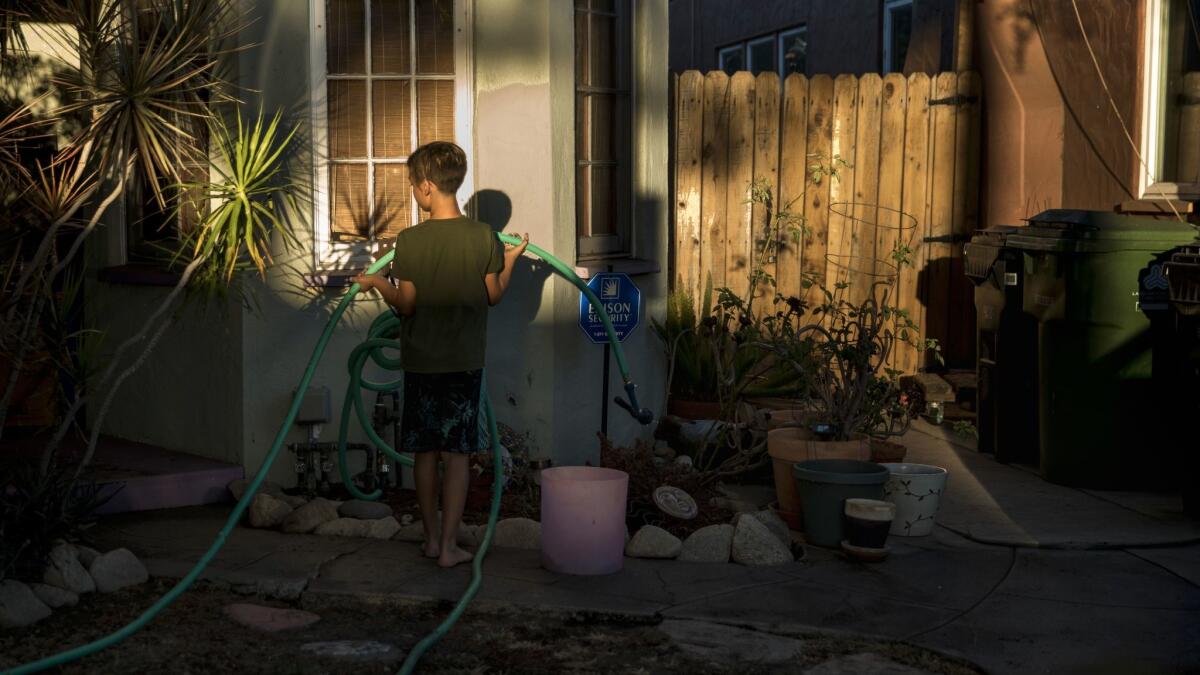Column: In L.A.’s misguided war on blight, an unpainted fence could cost you $660

- Share via
It’s the little things that beat you up in the end, the daily irritations and indignities.
Mail from City Hall, for instance. You know, even as you draw blood with a paper cut while opening the envelope, that it can’t be good news.
In Atwater Village, people have been receiving “courtesy notices” from something called the Pro-Active Code Enforcement division of the Department of Building & Safety.
The word “courtesy” is the first clue that your holiday spirit is about to be crushed, and “pro-active code enforcement” removes all doubt.
A colleague of mine got this notice about the gate to her back yard:
“PLEASE PAINT EXPOSED/BARE WOOD GATE AS NECESSARY AND MAINTAIN IN GOOD REPAIR. WHEN COMPLETE, CALL FOR RE-INSPECTION...TO AVOID A POSSIBLE NON-COMPLIANCE FEE OF $660.”
She couldn’t believe it. The redwood gate, once stained, has what might be called a “distressed” appearance. People pay good money to create such a look.
“It’s kind of shocking,” said David Silver, a neighbor who got the same “courtesy” note about his redwood gate.
He had actually stained and sealed his, but to a city inspector, it was another example of “visual blight.”
Silver called the inspector and asked:
“Are you sure you’ve got the right house?”
Silver said he explained that he’d treated the gate, and the inspector said okay, then don’t worry about the warning.
This was a hot topic on Atwater Nextdoor, the social networking site.
“I received one of these as well for my wrought iron gate,” said one resident.
“What is going on here?” asked another neighbor.
Dana Schwartz has a redwood gate, too. I went to see it, and I can tell you it’s in great condition.
But she, too, got the warning to paint it or pay $660.
“I haven’t done anything yet,” said Schwartz, who doesn’t intend to comply because she thinks the gate looks fine as is.
She wondered if the notice was some kind of scam. Others wondered if it were a plot to further gentrify the neighborhood, or if a handyman was trying to line up some work.
The answer is no.
This is for real.
Your tax dollars at work.
I called the inspector whose name was on one of the courtesy notices and pointed out that people use redwood because you don’t have to paint it. Redwood lasts a long time, has beautiful coloring and grain lines, and maintains its character as it ages.

“There’s a city ordinance that says you can’t have unpainted wood,” the inspector told me.
If that’s true, I think it could spoil Mayor Eric Garcetti’s dream of becoming president of the United States. People are always screaming that they want government off their backs, so who would vote for a man who runs a city that forces you to paint your wood?
I felt like I was already halfway down the rabbit hole, so I called the inspector’s boss, who referred me to Lucas Zamperini at Building and Safety. He sent me L.A. Municipal Code Section 91.8104 and highlighted the section on wood:
“All fences shall be maintained in good repair and shall be kept straight, uniform and structurally sound. Wooden fences shall be either painted or stained or otherwise treated or sealed in an approved manner to prevent their becoming a nuisance from weathering or deterioration.”
But it’s redwood, I said.
Zamperini said he doesn’t make the rules.
This is a city, I noted, with thousands of potholes and hundreds of miles of broken sidewalks uprooted by untrimmed trees, among other problems. If you sent members of the Proactive Code Enforcement team out to have a look, their heads would explode.
City Controller Ron Galperin just put out a report card on the general condition of 40 of the city’s 444 parks. Grades were high for recreation areas, but restrooms got an overall grade of C, with 16 getting Ds or Fs. At one park, the blight included litter and graffiti, worn out bleachers and dilapidated soccer goals.
What’s the fine for all that?
Blight is certainly a problem on commercial and residential properties, and it can be irritating for neighbors. (A blunt city report published in 2014 found that L.A.’s streets, alleys and empty lots of are so trash-filled it threatens the city’s image and makes some areas appear “unsafe and ungoverned.”)
But when it comes to private property, let’s go after the over-heaped dumpsters and front-yard car-repair operations.
That seems more important than the little stuff.
Zamperini said the crew in Atwater may need a little coaching to do just that.
“This is ludicrous,” said L.A. City Councilman Mitch O’Farrell, who represents Atwater. He told me he thought the program was supposed to assist people who can’t afford maintenance improvements rather than crack down on them.
Zamperini sent me a flier that offers maintenance assistance to those who are seniors, disabled or low-income, but O’Farrell said he was unaware of such a flier, and residents hadn’t seen one, either.
Zamperini said the residential Pro-Active Code Enforcement unit has been operating for 17 or 18 years and is currently funded through the federal Community Development Block Grant program administered by HUD.
OK, and how big is the grant?
Right now it’s more than $2.2 million, he said, which pays for 11 inspectors and two senior inspectors.
So in a city with a critical shortage of affordable housing and thousands of people barely hanging on as prices soar, we’re spending $2 million worth of federal housing money on courtesy notices in a blight abatement program?
If unpainted wood is a crime, why not go to Hancock Park or Pacific Palisades and drop some “courtesy notices” in mailboxes?
Because, said Zamperini, the program targets only low-income areas.
Which raises another question.
Some Atwater residents are on the lower end, but I wouldn’t call the hip and happening neighborhood low-income. And besides, to the extent that blight exists in bonafide low-income neighborhoods, it’s often because people can’t afford upkeep. So the solution is to threaten them with penalties of $660?
That doesn’t happen often, Zamperini said. Last year, 34,000 properties were surveyed, 3,401 “courtesy notices” were sent, and only about $6,600 in fees were paid, largely because most people complied with the ordered improvements.
If you get a courtesy notice for something trivial, do not give in, do not back off, and do not paint.
It’s time to rise up, calm down, and celebrate the fact that the Pro-Active Code Enforcement team will be off duty for the next four days.
Happy Thanksgiving.
Get more of Steve Lopez’s work and follow him on Twitter @LATstevelopez
More to Read
Sign up for Essential California
The most important California stories and recommendations in your inbox every morning.
You may occasionally receive promotional content from the Los Angeles Times.











